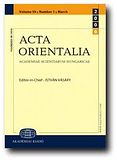Acta Orientalia 2010 - Vol. 63,4
Verfasst von pw am Mi, 12/01/2010 - 23:36.
Acta orientalia Academiae Scientiarum Hungaricae
Acta orientalia Academiae Scientiarum Hungaricae = A Magyar Tudományos Akadémia Orientalisztikai közleményei / Magyar Tudományos Akadémia <Budapest>. - 63,4 (2010). - Budapest : Akadémiai Kiadó, 2010
Erscheinungsverlauf: 1.1950/51 -
ISSN 0001-6446 (Print)
ISSN 1588-2667 (Online)
URL: Akadémiai Kiadó
Inhalt: 63,4 (2010)
- Csaba Dezső: Encounters with vetālas: Studies on fabulous creatures I, S. 391-426
DOI: 10.1556/AOrient.63.2010.4.1
Abstract: his paper attempts to outline the evolution and taxonomy of vetālas, one of the fabulous creatures that populate the religious culture of ancient and early mediaeval India. Sometimes misleadingly identified as “vampires”, vetālas had an important role in tantric rituals aiming at magical powers and performed in cremation grounds. Three such rituals are examined in this paper on the basis of both tantric and literary texts, all involving vetālas who sometimes appear as animated corpses, sometimes as jinn-like servants, sometimes as fully developed fabulous creatures bearing the characteristic marks of their species, which marks can also be assumed by deities. In the appendices a Kashmirian stotra to Bhairava appearing as a vetāla is edited and translated, and two vetāla doorkeepers are presented from a 12th-century Hoysala temple.
- Ferenc Ruzsa: The authorlessness of the philosophical sūtras, S. 427-442
DOI: 10.1556/AOrient.63.2010.4.2
Abstract: It has been generally recognised that the extremely important philosophical sūtras, most of them the oldest surviving texts of Indian philosophical schools, contain some interpolated material. In this paper the suggestion is put forward that their compositeness is of a far more fundamental nature, i.e. during the period of their formation — that could be half a millennium — they were not texts proper but memory aids for students. They must have been something like our handouts (but purely oral at the beginning), with different additions, deletions and interpretations in different places and times, without any fixed order or set number of contributors. The edited form of these texts that has come down to us derives from a late collector-editor who most probably wrote some sort of commentary as well on the sūtras. This unusual textual history suggests that we cannot really speak about the authors, the time of their writing or even their relative priority. Moreover, often there is no point in speaking about the true meaning of a given sentence or paragraph, as it may have had several ones in different historical contexts, and there is no available standard to establish which interpretation is more fundamental or original.
- S. A. S. Sarma: Why have the later ritual manuals of Kerala forgotten ‘initiation’?, S. 443-454
DOI: 10.1556/AOrient.63.2010.4.3
Abstract: Even though there exists a vast ritual literature of Kerala, topics related to theology and to the function of ‘initiation’ were taken up for discussion only in the early ritual manuals of Kerala, such as the Śaivāgamanibandhana, Prayogamañjarī, Ĭśānagurudevapaddhati etc. The later ritual manuals, such as the Kriyādīpikā, Tantrasamuccaya etc. did not deal with ‘initiation’ and instead prescribed a mantropadeśa in which the teacher (ācārya) teaches the mūla-mantra to the student. This paper will discuss in detail how the early ritual manuals of Kerala dealt with the subject of ‘initiation’ and will show how the importance of ‘initiation’ declined gradually and was forgotten by the later authors of the ritual manuals of Kerala.
- Michael Hahn: The Buddhist contribution to the Indian belles lettres, S. 455-471
DOI: 10.1556/AOrient.63.2010.4.4
Abstract: The paper aims at summarising the progress that has been made after World War II in collecting, editing, translating, and analysing the Buddhist contributions to classical Sanskrit literature. It demonstrates that the systematic search for manuscripts has brought to light many unknown works, among them veritable highlights of their respective genres, such as the play Lokānanda by Candragomin, the Jātakamālās by Saṅghasena, Haribhaṭṭa, and Gopadatta, a great number of outstanding hymns by Mātṛceṭa and his successors, and verse epics such as the Kapphiṇābhyudaya by Śivasvāmin, and the two late poems by Sarvarakṣita, namely the Mahāsaṃvartanīkathā and the Maṇicūḍajātaka. It is noteworthy that in many cases the oldest or even only specimens of various genres were composed by Buddhist authors.
- Gergely Hidas: Mahāpratisarāvidyāvidhi. The spell-manual of the great amulet, S. 473-484
DOI: 10.1556/AOrient.63.2010.4.5
Abstract: The present article is the first attempt to provide a critical edition and translation of a short Buddhist tantric work, the Mahāpratisarāvidyāvidhi. It was considered lost in Sanskrit up to this year when a Codex Unicus was discovered upon which the present edition is based. The text itself is a ritual manual describing how to prepare a protective circle or amulet of the Mahāpratisarā.
- Gyula Wojtilla: Reviews, S. 485-488
Ähnlich
- Indo tetsugaku bukkyōgaku ronshū 2014 - 2
- JICPBS 18 (2014)
- Zeitschrift für Indologie und Südasienstudien 2013 -- 30
- ARIRIAB 17 (2013) Supplement
- ARIRIAB 17 (2013)
- MSS 2013 - Heft 67,1
- Berliner Indologische Studien 21 (2013)
- Bulletin d'études indiennes 2012 - No. 30
- Bulletin d'études indiennes 2010-2011 - No. 28-29
- Acta Tibetica et Buddhica 2013 - 6

